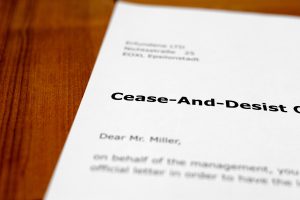Remember the days when you just sued someone, safe in the knowledge that it would be respectful, and you would win if you had the better case? Those days seem long gone, and now there is a difficult tightrope in deciding who, how and why to sue. Get it wrong and the public – particularly the internet – will feast.
The use of public relations and public opinion to put pressure on a person or a business is not new – the difference is the ready access to the ultimate publishing resource that is the internet, and the ability to share content so easily. The advice used to be that you should never write in correspondence something you would not want a judge reading some time later in caustic terms; now the question is whether you would want the entire internet poring over your words with only a half-correct appreciation of the law and a skewed background story from the recipient of the cease and desist letter.
Examples of individuals and companies getting it wrong in a PR world must go back long before the Barbara Streisand case, but that case marked a real change: Ms Streisand brought a case for breach of privacy, but the ensuing publicity meant that a significant number of people who would never have been aware of her address or what her house looked like suddenly became aware of it through reporting.
Alongside that we saw the rise of the narrative of the evil business: the global behemoth became less the benevolent paternal provider and more the wicked stepmother casting aside redundant staff, avoiding taxes and generally crushing all that is good in the world. The legal department became the obvious zenith, less a leather brogue and more a thick-soled boot to squash the inherently sweet but ill-advised member of the public.
The use of public relations and public opinion to put pressure on a person or a business is not new – the difference is the ready access to the ultimate publishing resource that is the internet.
Intellectual property is a particularly rich target for attack by the public: although it is ultimately quite difficult to understand (trademarks being often described as complex law applying to easy facts whilst patent law is easy law applied to complex facts), the fact that trademarks are around us all and are “easy” facts often means that we all think we can express a view on what the law should be. Often being that the big nasty company should be not so big and nasty and should let the newcomer or individual keep doing the questionable behaviour.
So, what is the solution? The first step many firms take can be to adopt a formal, legal approach: some will have seen letters before action that declare in 18-point bold that the correspondence is not for republication. Which is fabulous, except when it is going to an unrepresented party who has no idea what that means and proceeds to breach that requirement almost immediately.
The next (and perhaps optimal) step is to write a cease and desist which really aims at convincing: not just setting out what rights the client has and informing the recipient that they are – in the august and objective views of the writer – an infringement, but to explain in slightly more expressive terms why the behaviour is objectionable.
For some brands an even more extreme solution appeals. Brands like Netflix have crafted humorous letters to infringers which have not just diffused the risk of being seen as being overbearing, but have turned the tide in their favour against what would otherwise be a sympathetic infringer. In the case of Netflix, they have needed to combat a range of events and bars which “celebrate” the shows that have been particularly successful. Strangely, the public has tended to see such third-party activity as beneficial to the brand owner and seen the brand owner as being unfair if they sought to prevent others from doing so and getting the economic advantages. The correspondence Netflix sent on some of these cases has now passed into legal folklore as to how you can get it right, but it remains a difficult balance: get it wrong and you become the equivalent of a schoolteacher trying to buddy up to the students by using 80s street slang.
[ymal]
Of course, even within the UK legal system there are multiple opportunities to present the case in such a way as to garner sympathy from the judge and the surrounding public. Whilst pleadings before the UK Courts generally contain fewer dramatic flourishes and expressions of outrage than their US counterparts, there is always room for more august expressions which can be seized upon. One of the earliest things a litigator can learn is the importance of placing the “black hat” on the other side and portraying them as the wrongdoer, even in the tightest of legal arguments.
A recent example of where perhaps that could have changed perceptions is the OATLY / PUREOATY case, which was decided in the UK Courts and pitched these two brands from the oat milk market at one another. OATLY is one of the leaders in the sector and had a blue-tinged carton; PUREOATY was a later entrant into the market and used… a blue carton. Blue is not a common colour for food products (perhaps saved for the top of full-fat milk cartons) and reading through the case at one point the defendant sought to change the colour of their packaging to adopt a colour and style even more reminiscent of OATLY. The preponderant story which the press ran with, however, was that this was a ridiculous claim by a big brand trying to squash a small business. When the decision went the way of PUREOATY the press picked up on the case again and how it still nearly crippled the poor family-owned business.
One of the earliest things a litigator can learn is the importance of placing the “black hat” on the other side and portraying them as the wrongdoer.
Part of the difficulty in a case like PUREOATY, however, is that a case which is based on knowingly getting too close to the claimant is often difficult. If you have a history of copying (like some of the supermarkets) then it is an easy jump to make in pleadings, but where there has been no history of copying, to rely upon it is not an allegation that can always be reasonably made: this leaves the defendant to craft a narrative of a bullying claimant.
Equally, trying to force a party in that position to make pre-action disclosure of how they came to a design can be an expensive experiment. Where (as in OATLY/PUREOATY) the case is being brought in the Intellectual Property Enterprise Court with lower recoverability of legal costs and damages, bringing challenges and applications which could cost many thousands in irrecoverable costs is not attractive. The key question, however, may be whether – without that – is there the risk of commencing an action without a compelling narrative? With that comes the potential for a PR disaster which will have a much greater loss to the business.
Of course, the real strategy is to have a strategy; to know in real terms why you are contesting a third-party trademark or writing that cease and desist. In the world of brand protection, so often the needle swings between no action and frantic action when a brand protection programme starts – perhaps fuelled by seeing profits or opportunities lost to third parties, the business adopts a “zero-tolerance” approach – but mounting legal costs and too many claims often lead the brand owner to scale back to a far smaller band of issues. If there is a strong reasoning for the action taken then a business should be in a much better position from PR; either it will be a case which is easy to explain to the third party as being reasonable, or it will be a case which is important enough to ride out any negative PR storm.
PR can be a friend or a foe to legal proceedings. If a party has considered its position carefully and used correspondence and statements of case for the persuasive communications they are, then there should be little to fear. Get the approach incorrect, however, and it is just a matter of time before bad PR will bite.
Aaron Wood, Trademark Attorney
40 Oxford Road, High Wycombe, Buckinghamshire, HP11 2EE
Tel: +44 (0) 1494 478 676
Blaser Mills Law is a full-service law firm based in the UK. Over its 130-year history, the firm has offered a comprehensive range of services to individuals, SMEs and blue chip companies, regularly advising UK companies doing business overseas and international companies looking to invest in the UK.
Aaron Wood is a trademark attorney in Blaser Mills’ Corporate and Commercial team. He often works with brand owners, including numerous major UK firms, handling complex IP disputes on their behalf. He has also been ranked among the top 10 advocates in the UK Intellectual Property Office for trademark disputes (by number of appearances).





















